Identify horizontal and vertical lines and pairs of perpendicular and parallel lines - Reasoning

Maths Resource Description
Understanding the orientation and relationship between lines is a fundamental aspect of geometry that students must grasp. Identifying horizontal and vertical lines is the first step in this process. Horizontal lines are those that run from left to right across a page or surface and are parallel to the horizon. In contrast, vertical lines travel from top to bottom, perpendicular to the horizon. These lines are often used as references for orientation and can be found in various practical applications, such as in graphs and architectural drawings.
Once students can distinguish between horizontal and vertical lines, they can explore the concepts of perpendicular and parallel lines. Perpendicular lines are those that intersect at a right angle (90 degrees), resembling the shape of the letter 'T' when they meet. Parallel lines, however, never intersect; they are always the same distance apart, no matter how far they are extended. Recognising pairs of perpendicular and parallel lines is crucial for students as they delve deeper into geometric reasoning and undertake tasks that require spatial awareness and the ability to visualise and manipulate shapes and lines in various contexts.